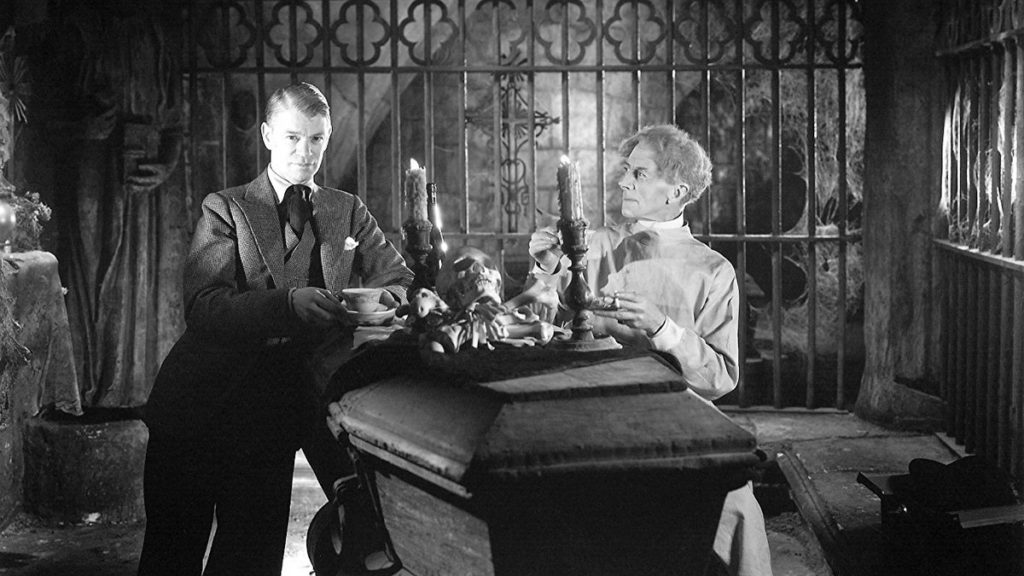It wouldn’t be the most glorious month of autumn without a little appreciation for the artistic genius of James Whale. A master of theater directing, he certainly did not need to work in Hollywood, but the horror genre would never have been the same without him. He virtually created the indelible link Universal Studios has with “monsters” of all kinds, which in turn chained him to the genre as well. Even directing the film adaptation of Show Boat (1936) with the incomparable Paul Robeson did nothing to disassociate Whale from those few classic films he is remembered for today.
When given his choice of his first film, Whale chose Frankenstein (1931) as a welcome change of pace from the stage play he had been directing about WW1. He brought his fine sense of art direction to the film as well as an actor who had been in his play, Colin Clive. Poor Clive would also forever be linked to his euphoric shrieks of “It’s alive!” as Dr. Frankenstein even though he was paired with Katherine Hepburn in a love story, Christopher Strong (1933) only two years later. Apparently not even Kate the Great could erase the vision of the mad scientist howling in triumph as his creation comes to life.
This was in great part thanks, or no thanks, to Whale. The set design and special effects would of course, become influential for decades of future filmmakers, but even Whale was not completely original. The laboratory and birth of the monster owe a debt to Fritz Lang’s Metropolis (1927) and the transformation of an evil robot into a doppelganger of virtuous heroine Maria (Brigette Helm.)
Film Road to Halloween: The Invisible Man (1933)
Of course, the star attraction of Frankenstein was the monster and the large, expressive eyes of Boris Karloff. But more dramatic than his eyes were his hand movements, which is not surprising considering all the makeup that he was forced to wear on his face. It is remarkable how sympathetic he could make his character with just gestures and some awkward grunts and moans. This would change in Whale’s true masterpiece, The Bride of Frankenstein (1935), in which the monster would develop the ability to speak with the help of a lonely hermit who befriends him.
Seeing both the original Frankenstein and its sequel together as one film is probably the best way of appreciating Whale’s artistic vision. His use of shadows and bursts of light in the laboratory that was the origin of both the monster and his bride is truly awe inspiring. His tight camera pans that follow the characters even seeming to pass through the walls of the tower where the lab is hidden and up dark twisted stairways are great creepy fun.
In Bride, Whale does something unique in setting up an introduction that features the author herself, Mary Wollstonecraft Shelly. That she is a woman and gets this screen time is impressive. That Whale makes it clear she could keep up intellectually with both her husband and Lord Byron is amazing considering that the female leads of his horror films were little more than potential victims that needed rescuing.
Between Frankenstein and Bride, Whale directed what remains a stunning achievement in special effects, The Invisible Man (1933). Closely adapted from the novel by H.G. Wells, the film was also the debut of Claude Rains in the title role. His beautifully suggestive voice was perfect to convey the menace and even the playfulness of the character Griffin as he succumbs to the madness that is a side effect of his invisibility. The slow unraveling of his facial bandages and then the shedding of his clothes to reveal nothingness underneath along with his maniacal laugh is still the stuff of nightmares.
Film Road to Halloween: Bride of Frankenstein (1935)
Whale filmed The Old Dark House in 1932, which was in the horror genre, but was more a comedy in the same vein as Arsenic and Old Lace (1944). Like the latter film, Raymond Massey plays a key role in Dark House but in Arsenic he is actually a stand-in for Karloff who was playing the same role on Broadway at the time. The Old Dark House has an odd, macabre family like in Arsenic, but they are visited by strangers in a storm who have no idea what trouble they’ve gotten themselves into. Karloff is again a mute, dangerous villain who terrorizes the women guests.
This is also the film debut of the real-life husband of Frankenstein’s Bride, Charles Laughton. Whale again cast his Invisible Man heroine Gloria Stuart as socialite Margaret Waverton. She is now mostly remembered as the aged version of Rose Dewitt Bukater in Titanic (1997).
Whale grew frustrated with a series of box office failures in Hollywood and returned to theater directing in the 1940’s. His ability to fully envision a film from the costumes to the lighting to the art direction made him a creative force ahead of his time. It is cinema history’s loss that he left but he might have been encouraged to return if a series of strokes had not disabled him in the 1950’s. Brilliant, demanding and a perfectionist down to every detail, James Whale gave horror films a sense of elegance and fun that is still influencing the genre today.

